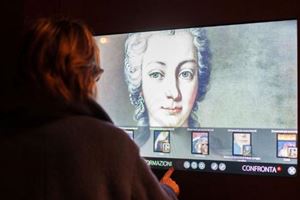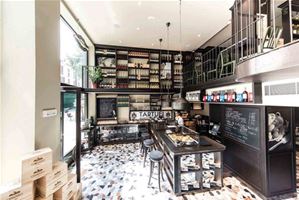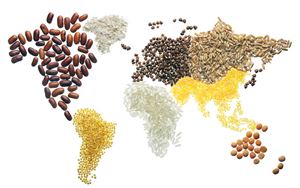In
anticipation of the return of the Calcio Storico, TF spoke to Simone Calonaci,
historic calciante for the Bianchi from 2000 to 2006, about what it’s like to play the game, its
recent history and what makes the Calcio Storico Fiorentino one of the greatest
games in the world.
How did you start playing
in the Calcio Storico?
When my dad took me to
matches as a boy, I watched the Calcio Storico with wonder and fell in love
with the game. It soon became my dream to play for the Bianchi, since I was
born in San Frediano. Then I started to play soccer in the Serie C for a team
in Campi Bisenzio, the Lanciotto Campi. In the meantime, I would go to see the
Calcio Storico every year. Then at 33, I decided to try playing. I knew a few
players on the Bianchi, so that’s how I got to my first training session. I
played my first game in 2000 with the Bianchi and it was a dream come true for
me. It also gave me the opportunity to make many great friends.
Tell me about the game.
What’s the aim?
The main aim is to
score. But how do you score? You score essentially by trying to take out the
other team’s players. The aim of most players is to pin their opponents down to
the ground and keep them on the ground for the whole match or hurt them so much
that they have to leave the field. It’s not uncommon during games for players
to get poked in the eyes, tear ligaments, sprain an ankle or get a shoulder
bone knocked out of its socket. It is much easier to score if you have more men
on the field than your rivals do. It gives the ‘strikers,’ the position I
played, the opportunity to score. Ninety percent of the time, the strongest
team wins the match. It’s physical strength and endurance that makes the
difference.
What is the training
like?
We train as any soccer
team would, doing various kinds of exercises, but we also do exercises in
wrestling. Then each session ends with a mock match. Clearly, the new guys must
‘pass the test’ in the training sessions before they can play a real game,
because if you are scared at training sessions then you’ll never last in a
match. The sessions are very difficult. If you are not good enough to play,
there’s a chance you’ll stick your team with one less player during the match.
So you have to be strong. To play, you have to be at your maximum, at 200
percent. In January, players start training twice a week for the Calcio
Storico; then after the Scoppio del Carro at Easter, teams train three times a
week.
Tell me about your first
game.
We had played against
the Rossi and lost 3 to 6. I’ll never forget the tension when everyone leaves
the field and it’s you and your team members face-to-face with your opponents.
Your blood races from the adrenaline mixed with fear and determination. That’s
when you think, ‘Why did I ever decide to do this?’
When did you play your
last game?
I played my last game
in 2006, when the whole controversy erupted and the tournament was cancelled.
The game never even started: a brawl broke out immediately and the game was
suspended. Some players, including me, were charged with aggravated assault.
I’m still in legal proceedings for that game that never was.
After 2006, the
tournament was cancelled for another year and it came back in 2008. In the
meantime, I had opened my restaurant, so I never started playing again, even
though I could have, had I wanted to.
How does one go from calciante to trattoria owner?
In addition to my love
for Calcio Storico, I have always had a passion for food. So, when the
tournament was suspended, I decided to open a trattoria, La Burrasca, with my
partner, Elio. I had worked in the San Lorenzo area at Trattoria Mario for
eight years and it was like going to food university! I learned a lot, but I
also wanted to test myself to see if I could make it on my own in the
restaurant business. So when the opportunity arouse, I took it. We serve
seasonal foods, which is easy with the central market being so close. Our menu
changes every day because I get bored easily.
What about the city’s
stricter rules to ‘clean things up?’ Were they effective?
I think that the
regulations they introduced in past years failed to provide a real solution to
the problem. The new rules should have penalized those who punch others from
behind or those who kick others on the ground, and those who test positive for
doping. The problem was that they never made players and teams respect these
rules. The Questura should never have been involved in Calcio Storico in the
first place: it’s a sport and a traditional event. I say this because no one is
paid to play Calcio Storico. We play for free. We play because we love
Florence. We choose to play because we are Florentines.
Why did things escalate
so much in those years before the event was cancelled?
The players started
taking the game too seriously and taking the game into the streets all year
long. Players from rival teams would fight if they saw each other in a
restaurant or a bar. Tensions escalated so much that some players were even
shot at. The sense of sportsmanship was lost.
Do you think there will
be less violence this year?
I think so. The good
thing about the new rules is that fights must be one-to-one, so there shouldn’t
be any big brawls or cheap shots from behind. This will definitely make the
game ‘cleaner.’ People in the stands come to see the Calcio Storico because
they want to see fighting. It is not something that you can take out of the
game: if you did, it wouldn’t be Calcio Storico! I think these new rules will
help keep things in check and ensure good, clean fights.
How do you feel about the
Calcio Storico now as a spectator and no longer a player?
Every time I walk
through Santa Croce at this time of year, and I see them setting up the
grandstands, I still get goose-bumps. I still watch it with the same enthusiasm
I had as a child. But I can’t go and see the Bianchi play, it’s too emotional!
It is an incredible game: e’ crudo, ma bello. I’ve never felt such strong emotions
playing a sport than when playing calcio in costume. It’s a game in which
you face your opponent and see exactly who he is. You see who really has balls
and who doesn’t.
CALCIO STORICO: THE GAME
Calcio Storico
Fiorentino is an early form of football that originated in Florence in the
sixteenth century. Every year, three matches are played in the third week of
June. Teams of 27 battle it out on a large sand pit in piazza Santa Croce.
Using both feet and hands, players try to score by throwing the ball over a
designated spot on the perimeter of the field. Each game is played out for 50
minutes with the winner being the team with the most points.
Highlights of the rules
for Calcio Storico 2011:
Any player with a medical certificate attesting to his health
can participate.
Players involved in certain legal proceedings are eligible to
participate.
Players may fight one-on-one, but if a third person gets
involved, the game will be halted and the entire tournament will be suspended.
There is no longer an age limit for players
Teams who forfeit will relinquish their right to a clubhouse,
training field and city funding.







